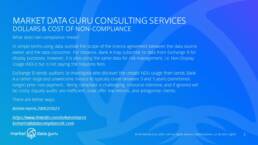

MARKET DATA GURU CONSULTING SERVICES: DOLLARS & COST OF NON-COMPLIANCE
1 A LOSE-LOSE SITUATION
Right now virtually all producers and consumers of market data are losing copious quantities of money directly or indirectly because of non-compliance, and the problem is there is no one single cause, there are a myriad of reasons.
Financial institutions in the hole for $1.7 Billion p.a? Merely the baseline figure for single audits, because where a financial institution is not compliant with one exchange it is invariably not compliant with many others. From even the smallest broker or fund manager subscribing to a minimal number of sources to a Tier 1 bank managing 500+ that $1.7 Billion p.a. starts to look very small indeed, especially when one considers this is an extrapolation of the average settlement figure, i.e. findings are usually far higher but exchanges get negotiated down and auditors rarely succeed in identifying the true dollar figure of out of scope market data usage. So the exchanges lose out because they do not get the full dollar amount that previous usage entitled them too.
At first sight this seems like a good deal for the Bank, they get massively discounted data usage, and the market data manager gets a bonus for all those dollars saved. However the environment has changed with increasing regulatory and compliance risk putting commercial reputations on the line is forcing Banks to try harder to become compliant.
For larger financial institutions, exchanges fixation on audits are a nasty fact of life, many of the largest data users like hedge funds and proprietary traders rely on a level of anonymity (and exchanges not knowing what they do) to avoid audits. While most again try to be compliant there are some which do not, and given the high cost of market data gain an unfair competitive advantage of their more honest peers. Something regulators should but do not pick up on.
In fact given that back fees are generally charged over the preceding 3 to 5 years, financial institutions’ potential total liabilities at any one point are more like $6 Billion, and that is being conservative.
2 CHANGING PERSPECTIVES, ADOPTING POSTIVE APPROACHES
Financial Institutions
For the financial institutions being non-compliant is now not only a financial risk, it is a reputational risk, as well. Being non-compliant in one area generally means there are issues elsewhere. If regulators take a balanced approach in their current reviews of market data services unfair practices then this ought to be a major focus with emphasis on those houses which deliberately engage in out of licence data usage.
Financial institutions require better internal reporting and analysis of usage, not only to be compliant but also to keep costs down over the long term. They require market data strategies which reflect dynamic business needs and eliminate exposures as they occur through planning and process management based around having the right tools in place. This approach is often not taken because accountants avoid ‘costs now’, which invariably leads to a large bill landing on the desk later. Also being pro-active smart houses can reduce potential back fees.
Compliance now is always the most cost effective solution and if knowledge resources are not available in-house there are some very good consultants around (including us!). It is all about data workflows, especially as in our consultants experience financial institutions found during cost review projects an average overspend on market data by 26%+.
Vendors
Too many vendors’ sales teams avoid the nasty skeleton in the closet of exchange data licences. A more upfront approach is required about informing clients of requirements, but it is not their duty to policy the exchange’s clients usage on their behalf. That is unfair as well as labour intensive.
The problem for vendors is their own reporting is poor, inaccurate, and too focused on display devices with their permissioning/entitlement systems only able to monitor limited usage. This needs to be changed as not only do they suffer revenue leakage as a consequence, it feeds downstream to their data consumers, and upstream to the data sources, i.e. exchanges.
Exchanges & Data Sources
Sole reliance upon limited vendor reports and particularly audits does not work. Audits should always be part of the exchange’s compliance tools but used according to real need. The idea of utilising audits for revenue generation is laughable (as it deliberately ignores the root causes of past non-compliance) and is simultaneously antagonistic. Too often auditors inflate ‘findings’ because they know they will get knocked back in negotiations which quite rightly reduces any credibility the audit actually has to tatters. Equally exchanges pay auditors such low fees there is little incentive to do the job properly. On top of that the same names always appear on an audit programme, Tier 1 banks and well known financial institutions.
At the same time vendor usage reports are rarely analysed and even when understood contain either incomplete or incorrect information.
The root causes of the problems, all of which can be solved with a positive approach are:
1.Making licences, policies and agreements transparent and understandable (communication helps as well) which is a leading cause of non-compliance
2.Common standards for terms and conditions on a global scale. There is too much interpretation
3.Most importantly switch from audit let strategies to compliance review led strategies. Instead of fishing for findings marketdata.guru and Ian Pearson IPCL’s consultants have worked with exchanges to identify in advance where non-compliance is taking place by whom, and why, then work with the data consumer to solve the problem on a ‘go forward’ basis. When an exchange has 1,000+ clients only a fraction can be audited at any one time, through compliance reviews multiple times more clients can be analysed and engaged with annually resulting in far quicker resolutions arrived at in a friendly environment. In context, compliance reviews can be completed before a financial institution has even acknowledged an audit letter.
Without any changes in strategy exchanges will continue to see 22%+ dollar data leakages every single year.
3 MAKING IT A WIN-WIN SITUATION
The good news is there are positive ways forward to end the current, and often hostile, environment. This will come partially from the data consumers and vendors, but the greater onus is on the exchanges and other data sources to adopt a more customer friendly proactive approach. For all data consumers and exchanges alike, if the resources are not available internally, get them in as they pay for themselves multiple times over (we know from delivery).
Better compliance is a positive for all parties because:
1.Reduces long term costs for the data consumers, squeezing out overspend while introducing data workflow and management stability
2.For exchanges it produces a more client friendly regime, increases revenues, and importantly reduces the need for many exchanges to constantly rely upon just raising prices to drive the bottom line
4 SUMMARY
At the moment too many resources are being wasted by all parties on non-compliance. By creating a better environment with known data workflows it will free up these resources to focus more on their real day jobs and build better and more profitable businesses for financial institutions, vendors, and exchanges.
Keiren Harris 28 February 2023
For information on our consulting services please email knharris@datacompliancellc.com
Please contact info@marketdata.guru for a pdf copy of the article


